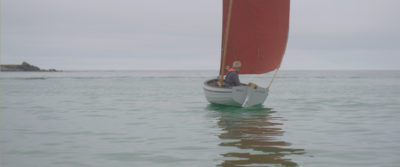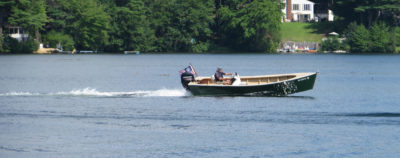Designing a small boat that can be rowed easily, is stable in a variety of sea conditions, and is a pleasure to look at has challenged generations of builders and trained marine architects. The most successful results have evolved as one designer has influenced the next until something perfect, or close to perfect, emerges.John Hartsock grew up rowing a variety of small boats, and his experiences with the best of them led him to regard their designers as being “wonderfully intelligent people with an intuitive feel for hull shape and a willingness to communicate with one another.” As an engineer and computer programmer, he was convinced that a superior rowing boat could also be designed from a set of mathematical equations. His conviction eventually led to the 14′ Cosine Wherry. Its similarity to a Whitehall rowing boat is both a nod to the designers and builders of the 19th century, and confirmation that his mathematical approach to design worked. John’s detailed explanation of his approach can be found in WoodenBoat, May/June 1991, or at Concrete Canoe. The author's Cosine provides a clear view of the hull's interior. The strips in the bottom of the hull run parallel to the keel; those forming the topside are parallel to the sheer. The transition is at the turn of the bilge. Paul McCuish
Paul McCuish
Join The Conversation
We welcome your comments about this article. If you’d like to include a photo or a video with your comment, please email the file or link.





























I built two of them ! John Hartsock sent me the plans to elongate the wherry to 16′. We equipped the first one with a daggerboard and a 76 sq.ft. spritsail. We had much fun rowing and sailing the wherry at Klopeinersee (Lake Kolpein), Austria, and between some islands in Dalmatia/Adriatic Sea. The boat was built lightly (110 lbs), could be transported on top of our car but the long straight keel without any rocker made tacking difficult. In stronger winds we often got stuck “in the irons”and needed some strokes with a paddle to come about. The spritsail was equipped with a handy brailing line but reefing in strong winds, out there was arduous.

Because it was a good boat, I built a second one and some slight modifications were made : I increased the rocker a little bit and cut down the keel in the forefoot. This improved tacking very much. Then I slightly increased the sheer line by 3/4” and I switched from spritsail over to a balance lug-sail of the same size. So reefing the sail is easily done and the former uncontrolled rolling when sailing downwind with the spritsail is not noticeable anymore. The new wherry is a bit heavier (160 lbs) and feels more stable when stepping in. But the Cosine Wherry is designed as a rowboat, so because of the limited width and the low sheer line, which is good for rowing, we are often sailing “on the rails.” We sailed and rowed our new wherry at some raids in Venice Lagoon, had much fun and we were quite successful.
How did Hartsock choose to stretch the boat? Did he stretch the middle or each station? Where the molds the same or were they enlarged as well? Please add detail. Thank you.
I finished mine in 2000. It weighed about 80 lbs new before many coats of varnish over the years. I put it on a modified jet-ski trailer after I saw how rough car-topping was on the softwood gunnels. It got hit on the highway and isn’t perfect after patching but is a great little boat. Never a sail or motor of any kind on it.
HI there. Thanks for the great article, and I love the bit about MAGGIE!
I became the proud owner of the original cosine wherry a couple of years ago, purchased from John’s son. 🙂 It needs some TLC, though, and I want to do it right! I am not sure if I need to sand the entire boat, or just the most worn spots? I noticed that when building it, you used fiberglass cloth and fiberglass – necessary? Shall I buy the Rip, Strip, and Row book (if I can find it)? Thanks for any help you can give me. I am a rower (shells) and have the Cosine wherry at my lake cabin; she is lovely to row! She always gets looks and, most of the time, compliments. 🙂
Thank you so much!
Neighbor to the south – Seattle
Peg Radford
John Hartsock sent me the following specifications to elongate the wherry from 14ft to 16 ft.:
SPACING OF STATIONS
0 to 2 increase from 9″ to 10,3″
3 to 13 increase from 12″ to 13,7″
13 to transom increase from 18″ to 20,6″
Shape of stem: Increase horizontal dimensions by 16/14, do not change vertical dimensions.
Transom angle: Increase from 15 to 17 degrees
Another reason for the thwart knees is to strengthen the topsides when the boat is rolled onto its side on a beach. Otherwise, cracking of the topsides where the thwarts contact may happen due to the stress-riser effect.
The Cosine Wherry is a hardy little boat. For a fixed-seat boat it’s surprisingly quick for its length when rowed as a double. I built one in 2014. We’ve taken up & down Puget Sound loaded with camping gear a number of times. We rowed it to Seattle from Bainbridge Island one November night. Came back in a storm the next day. It did very well.
